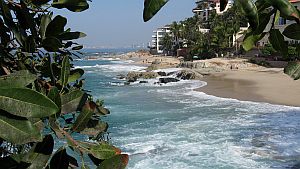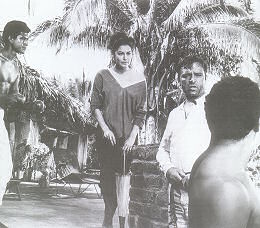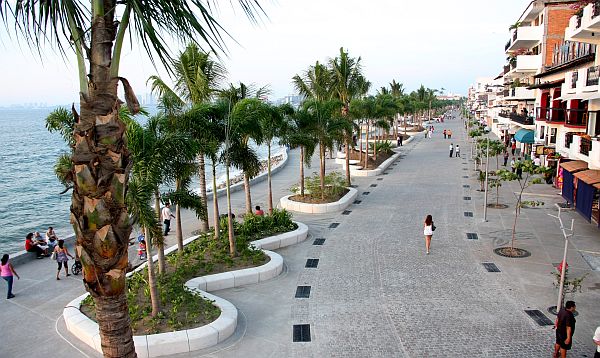Puerto Vallarta, Mexico - Early in the morning, joggers and dog-walkers are the only ones on the Malecón, the seaside boardwalk separating the white-sand beach from the cobblestoned street with its row of shops. Often there is a slight haze in the air, softening the Pacific's blue and blurring the sharp edges of the high-rises seen in the distance, across the bay.
At this hour here in the Romantic Zone, the only sounds are the waves as they curl onshore and the occasional whoosh of a passing vehicle. The row of whimsical bronze sculptures along the Malecón - among them a boy riding a seahorse, a couple in love, and pillow-headed figures climbing a ladder to the sky — are their only company. This is not an early-rising city, and the shops and restaurants are still closed.
On the quiet side streets that climb steeply toward the hills, people leave homes and apartment buildings to do their daily shopping as they would anyplace - as though they weren't living in one of the most beautiful and romantic ocean-side cities in the world.
 |
The curving white-sand beach nearby fringes one of the world's largest and most famous bays, the Bay of Banderas. And the city that hugs its shores is the legendary resort of Puerto Vallarta, Mexico.
Puerto Vallarta is certainly romantic. It's a favorite spot for weddings and honeymoons. But this city has more than romance going for it. It's also one of the world's top retirement havens. It's easily accessed from the U.S., boasting first world-standard infrastructure, and is home to one of the biggest established communities of foreign retirees anywhere. As many as 10,000 expats live here full or part-time. The best news is that, despite Puerto Vallarta's international appeal and glamorous cachet, the cost of living and real estate remains surprisingly affordable.
Until the 1950s, Puerto Vallarta was a small fishing village along spectacular bay on the Pacific that was modestly popular among Mexicans for its beach. Then, in 1962, John Huston filmed The Night of the Iguana in Mismaloya, a seaside village just south of Puerto Vallarta.
 |
The film's star, Richard Burton, was involved with actress Elizabeth Taylor at the time. She followed him on location, and the paparazzi followed her. Suddenly Puerto Vallarta was all over the news, and it became a recognizable place on the map for Americans. And it’s remained there ever since.
Burton and Taylor both eventually bought houses in Puerto Vallarta, which attracted other jet-setters to the area. At about this time, the Mexican government began to invest heavily in infrastructure—highways, roads, and public utilities - all of which made Puerto Vallarta more accessible and more attractive as a tourist destination.
Luxury hotels began to spring up, and American tourists, especially from the Western states, came in ever-growing numbers. Today Puerto Vallarta is a sophisticated resort town and the second-biggest tourist destination in Mexico.
Walking around Vallarta, you get that happy, vacation-time feel that successful beach resorts engender. Yet, you can have a great time here even if you never set foot on the beach. Zip-lining, horseback-riding, hiking, and many other outdoor activities are inland. Cultural activities like plays, films, jazz and classical concerts, gourmet restaurant festivals, and gallery openings fill the city's calendar. And you can always spend a pleasant afternoon strolling through the city's neighborhoods or viewing artists' wares from pottery to painting.
Puerto Vallarta is also one of Mexico's most cosmopolitan beach resorts. Half the population works in the tourism business, so English is widely understood. This is a big plus if you're looking for a retirement destination overseas where you won't have to learn a new language.
 |
Yet beneath the international veneer, the core of the city remains very Mexican. In the older parts of town, traditional white-washed houses with sloping red-tiled roofs line the cobbled streets. Little green-grocers selling fruits and vegetables are a staple in some neighborhoods. And you still find local restaurants where a filling, home-cooked lunch can cost you just $8.
Puerto Vallarta's historic center, also known as El Centro or downtown, is the oldest part of the city and its heart. This is the area running north of the Cuale River to the Parque Hidalgo and near the parish church of Our Lady of Guadalupe. The beachfront area - including the Malecón and the street running beside it - are busy with tourists from mid-morning until late at night. For several blocks back from the beach, the ground floors of buildings are commercial property housing bars, restaurants, galleries, and shops.
Centro is a lively, fun area, but it can be noisy at times, and options for daily grocery shopping are limited. For these reasons, it isn't the best option for full-time living. However, it can be a great area for a rental property, and you can find small (about 60-square-meter) condos for sale here starting in the low to mid-$100,000s.
A much better choice for full-time living is the up-and-coming neighborhood of 5 de Diciembre, just north of Centro. This neighborhood is just a few minutes' walk from Centro's shops, restaurants, and street action, yet parts are much more residential. Here you can stroll along streets of low-rise, brightly colored buildings surrounded by trees and flowering shrubs.
Monthly rates for one or two-bedroom condos on a long-term lease start at about $800 a month. Realistically, you'll find many more on offer for $1,000 to $1,500 a month. If your monthly rental budget is in the $1,200 range, you should have a number of properties to choose from in several areas of the city.
Many expats and retirees living full-time in Puerto Vallarta came first on vacation, fell in love, and decided to return more permanently. Perhaps one of the biggest reasons for the region's still-expanding popularity is that life here isn't all about the beach. Yes, the sea is an ever-present feature, and the ocean breezes cool Puerto Vallarta in the hot and humid summers. But you can build a life here that includes all the amenities you're used to at home, and be very happy even if you're not what might be called a "beach person." Puerto Vallarta is a real city, a place where you could jog on the Malecón alongside the blue Pacific in the early morning, then have a coffee on the terrace of a café overlooking the bay.
Kathleen Peddicord is the founder of the Live and Invest Overseas publishing group. With more than 25 years experience covering this beat, Kathleen reports daily on current opportunities for living, retiring, and investing overseas in her free e-letter. Her book, 'How To Retire Overseas—Everything You Need To Know To Live Well Abroad For Less', was recently released by Penguin Books.


